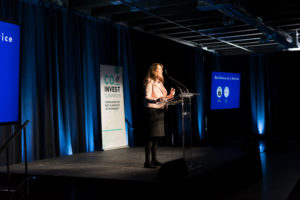
Katie Kollhoff, Co-Founder and CEO of NUMIX Materials and the winner of the 2020 U.S. Bank Foundation Cleantech Inclusion Award, at Co_Invest Cleantech 2019
It’s no question that cleantech, greentech, climate tech, whatever you want to call it, has become a hotbed of innovation over the past few years. Entrepreneurs and investors alike are flocking to this sector, and amazing technological and business advancements have been realized. At Clean Energy Trust, we have seen some truly impressive startups grow into successful businesses and are proud to have invested in some of the most promising ones.
As these new startups pop up at an accelerated pace, it is crucial for founders and entrepreneurs to form effective best practices in leading their teams and managing the growth of their organizations. New ideas and technological breakthroughs abound in this new era, and leaders at the forefront of this space must properly nurture them to realize their potential.

Intelligent Leadership
As a leader, you are only effective when you understand the human dynamics of your organization and harness this understanding into organizational intelligence. A lot of this can come from introspection, but ultimately, you need to communicate with your employees and understand what they value and need.
1. Know why your employees want to work for you
This is crucial to determine even before you hire employees, though it is also important to understand on an ongoing basis what your employees’ motivations are in working for you or at your company.
- Are they motivated by an above-market salary or benefits package?
- Did they have close friends at the company who encouraged them to apply?
- Do their personal values align with your company’s mission?
Each individual’s motivations may be different, and especially in small teams, these motivations can inform you on how to best engage your employees to maximize productivity and ensure organizational cohesion.
Many cleantech startups have strong organizational alignment on environmental impact. If this is something your employees care about a lot, double down on impact-focused performance metrics to communicate progress and align everyone on common goals. It is much easier and more motivating for employees to work towards delivering on specific, measurable goals than for them to try to manifest a broad mission statement.
2. Know when to step aside
Entrepreneurs and founders do not always make the best long-term CEOs. In a quickly growing startup, there often comes a time when the team outgrows the loose, entrepreneurial organizational structure it started with and new management is necessary to realign the business. Especially for technical founders who have invented the startup’s core technology or otherwise are key to the startup’s technological development, understanding the technology and/or product is not enough; growth-stage businesses need strong managers who have the skills and experience to best leverage organizational resources to maximize the value and effectiveness of the startup’s product in filling a market need.
This is not to say that founders should never be long-term CEOs, as many notable examples exist where founders have led their businesses to become huge successes. However, not all founders are the same, and not all businesses need the same type of leader. As a founder, your most important job here is to understand your strengths and limitations as a leader and recognize which role you should take on to best serve the business.
3. Seek mentorship and support
Leadership should never have to be lonely. In fact, it is imperative for founders to build a support network early on in their startups’ lives. Whether it is with employees, investors, fellow founders, or others, sharing the mental and emotional burden of leadership is crucial to making informed decisions and being an effective leader. Entrepreneurship is a collective game in which founders can build upon the learnings of past successes and failures from others who have played, and successful founders build large, diverse networks of peers and mentors from whom they can draw these learnings.
When building your network as a cleantech founder, it is important to seek advice from non-cleantech experts as well as those from within the cleantech ecosystem. Startups across different sectors can face similar challenges in scaling up, and creative solutions can be drawn from unconventional sources.

Sustainable Growth
Growth is the name of the game in the venture community, and investors and founders alike seek aggressive growth as an indicator of a startup’s success. However, sustainable growth involves much more than quickly onboarding hordes of customers.
It is easy to get caught up in a new and exciting trend, particularly in a hot sector like cleantech, so it is important to keep in mind that not all growth opportunities can persist in the long run. To achieve sustainable growth, you need to ground yourself and your company in what your customers need, how your product is unique, where you will go along your product adoption curve, and how you will respond to feedback from the market.
1. Understand your customers’ pain points
Everyone preaches product-market fit, but what does it actually entail? Beyond just chasing a market trend, your innovation must solve some problem for your customers that is important enough and worth paying to be fixed. That is, you should have a precise understanding of the specific needs your customers are seeking to address and how much they are willing to pay to satisfy those needs.
Once you have this understanding, ingrain it in how you communicate the value proposition of your product or service. You should always frame your pitch in the context of your target customer’s problems because the fundamental purpose of your innovation should be to deliver value by solving these problems.
In the cleantech and climate tech arena, I often see pitches focused on tackling some big, nebulous problem such as “solving the climate crisis” or “eliminating pollution.” This is one of the biggest turnoffs for me as an investor because it fails to provide any evidence of value for the startup. These lofty goals are in fact externalities rather than tangible objectives; by offering your product or service to your target market, you may be incentivizing certain behaviors that may contribute to a reduction in greenhouse gas emissions or sources of pollution, but your solution is almost certainly not a be-all and end-all to either. Focus on the parts of your value chain that you can directly affect, and communicate tangible value.
2. Find product-market leadership, aka competitive advantage
Finding product-market fit is the first step, but when you have potential competitors to worry about, it is insufficient by itself. Not only do you need to effectively serve a valuable market, you need to do it in a way that others can’t. As such, one of the first questions I always think about when evaluating a startup for investment is, “why is no one else doing this?”
This brings us to a competitive advantage. At its core, competitive advantage is about performing better than others. If your idea is so brilliant, what’s stopping everyone else from doing the same thing? Note that there are two parts to this equation: knowing what it is that your product can do better than anything else, and understanding what “anything else” includes. Understanding your value in the market is just as important as understanding your positioning relative to your competitors. Both are essential to leveraging your competitive advantage into actionable, communicable value.
It is especially important to differentiate in a hot space like cleantech. Got a new building automation software? Great, how does it save your customers more money on HVAC and lighting costs than the dozens of others out there that have already raised tens or hundreds of millions in funding? Or maybe you are presenting a new lithium-ion battery anode chemistry. Very cool, but how does it compare on energy density, safety, charge rate, and cycle life? These are obviously examples of highly competitive industries where performance metrics are well established, but even in markets where competition is not as clear-cut, you must be able to communicate why your product is better than the status quo.

3. Map out your product adoption curve
The S-curve of product adoption is the paradigm for all new innovations. After an initial build-up of awareness, adoption accelerates, hits an inflection point, and plateaus towards saturation at maturity. Despite the simplicity of this concept, the path along this curve can be difficult and quite complex.
The biggest problem with the high-level notion of the adoption curve is that it paints a picture of a monolithic customer base. While it is easy to interpret the rate at which new customers buy your product, you will inevitably need to improve or build upon that product to match the needs of your marginal customer. Your pilot customers, beta testers, and other early adopters will not have the same needs as your average customer at scale. Bugs and kinks will need to be worked out, and large components may need to be fundamentally changed. The point is, you should not assume that what you have today will be what your customers need tomorrow.
As part of this reflection, it is important to map out your path along the adoption curve within the context of customer needs and product milestones. Your minimum viable product and version 1.0 may be enough to get a few hardcore fans or innovation-hungry futurists on board, but what do you need to develop for the next group of adopters? This idea goes back to understanding your customers’ pain points. What is the universe of problems you are trying to solve for your customers, and how does that universe change as you target new groups of customers?
Let’s say you are a cleantech entrepreneur who has developed a new material to make plastic composites lighter, stronger, and more durable. Your product adoption curve encompasses the broad industry of composite materials, and your early adopters are small producers of high-performance sporting goods such as skis and snowboards. Their needs will be drastically different from, say, automotive manufacturers that you plan on selling to down the road. Maybe it’s a difference in price or volume. Maybe it’s color or formulation. As a founder, it is your responsibility to understand how these needs evolve as you scale up.
4. Respond and adapt to market feedback
Once you have done all of the prep work in the above, it’s time to go out there and get to work pushing your way into the market. In doing so, it is important to remember that a big part of this journey lies in your company’s relationship with your customers and the broader market. The acceleration of your startup’s growth is deeply dependent on your ability to collect, filter, and act upon feedback.
Customers are picky, and they have every right to be. In fact, market efficiency requires them to be. Tastes and preferences change, new innovations enter the market, and the economy moves independently of what your startup does. To survive in this dynamic world, you need to respond to feedback and adapt to stay relevant.
In engaging with your customers, always be aware of relative value in their preferences and directional trends in what they want. Beyond having awareness of the various pain points you solve for your customers, understand how your customers prioritize these pain points. Maintain your own ordered list of features or benefits that your customers like about your product, and know why the list is ordered that way. Better yet, break down your unit economics and cost-benefit analyses into tangible components of value based on your customer’s preferences. Then, think about how and how quickly these benefits can change in magnitude and order.
Once you have mastered an understanding of this customer preference dynamic, reacting to and even anticipating your customers’ needs should become second nature. Having the ability to do this is itself a potential source of competitive advantage and will make you and your product the go-to problem-solvers for your customers. This is ultimately how startups grow into mature businesses.
In the cleantech world, this is how green technologies become mainstream, how “climate tech” becomes just “tech.” We are currently in the midst of a societal paradigm shift towards rapidly increasing recognition of the urgency of climate change, and incumbent businesses are getting overwhelming market feedback demanding sustainability and accountability. How these incumbents respond to this feedback will determine how long they exist, and in the meantime, your opportunity as a cleantech founder is wide open.

Parting Thoughts
Leadership and growth management are both essential for successful cleantech ventures. Whether you are just starting out with an idea or have been hard at work on your business for years, it is essential that you keep in mind what your team and your customers need. As a founder bringing impactful innovation to life, and as a leader inspiring others to join you in this process, you are a steward of progress in today’s society.
I am personally excited to remain plugged into this ecosystem and to continue hearing about crazy new ideas being brought to life. As an investor, it is my job to discover but choose, support but challenge, and evangelize but ground in realism the best of these ideas. Being able to engage with intelligent leaders who drive sustainable growth just makes my job easier and more enjoyable.


